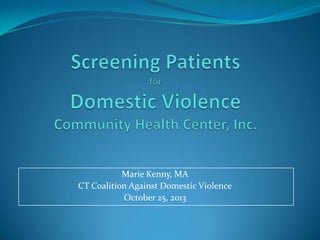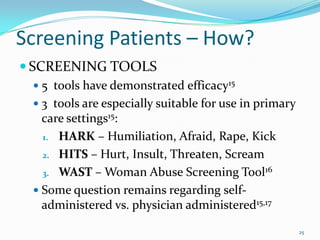Screening Patients for Domestic Violence
- 1. Marie Kenny, MA CT Coalition Against Domestic Violence October 25, 2013
- 2. Financial Disclosure There is a financial relationship between CCADV and CHC, Inc. CCADV provides some funding to New Horizons, a CCADV member program within CHC, Inc. 2
- 3. AGENDA ’éŚ Defining Domestic Violence ’éŚ Prevalence ’éŚ Dynamics ’éŚ Screening Patients ’éŚ Why? ’éŚ ’éŚ Benefits for Patients Benefits for Providers ’éŚ How? ’éŚ ’éŚ Enhancing Safety Building Confidence ’éŚ Following Up with Patients 3
- 4. Defining Domestic Violence Why Routine Screening? ’éŚ 1 in 4 women experiences domestic violence in her lifetime1 ’éŚ 40% of female adolescent patients seen at urban clinics had experienced IPV2 ’éŚ 21% reported sexual victimization2 ’éŚ More than half (53%) of women seen at family planning clinics reported physical or sexual IPV3 ’éŚ $4.1 billion is spent annually for direct medical and mental health services related to IPV4 4
- 5. Defining Domestic Violence CCDAV Programs Provided (FY 13) ’éŚ Crisis intervention services to 25,130 individuals ’éŚ Calls to statewide and individual agency hotlines ’éŚ Safe Home Services to 2,069 victims ’éŚ 1,220 adults and 849 children received emergency shelter ’éŚ Community Services to 13,949 victims ’éŚ Individual counseling, safety planning, support groups, legal advocacy and information & referrals ’éŚ Criminal Court-based services to 39,585 victims ’éŚ Safety planning, counseling, court advocacy, assistance with orders of protection, information & referrals www.ctcadv.org 5
- 6. Defining Domestic Violence ’éŚ DV goes by a variety of names ’éŚ IPV, abuse, battering, dating violence ’éŚ Certain elements are universal ’éŚ a PATTERN ’éŚ of BEHAVIORS ’éŚ to establish and maintain CONTROL ’éŚ over an INTIMATE PARTNER 6
- 7. Defining Domestic Violence BEHAVIORS ’éŚ Psychological Denial and minimization of abuse, monitoring, jealousy, social isolation, ŌĆ£Jekyll and HydeŌĆØ public vs. private persona ’éŚ Financial Sabotage of school or work, denying access to accounts, car or phone, making unilateral spending decisions, making threats about public assistance, destroying credit, shutting off utilities, etc. ’éŚ Emotional Degrading, humiliating, condescending, threatening, guilt-tripping, using kids ’éŚ Sexual Coercive sex, rape, threatening to ŌĆ£outŌĆØ a partner, cheating, reproductive coercion ’éŚ Physical Does NOT always leave a mark, can be infrequent, throwing or breaking things, intimidation tactics can be very subtle to others 7
- 8. Defining Domestic Violence DEMOGRAPHICS ’éŚ Typically male on female BUT not always ’éŚ Some men are victims of women ’éŚ Similar rates for same sex relationships5 ’éŚ MOST men do not abuse their partners ’éŚ Prevalence cuts across all demographics ’éŚ Impacts all racial, ethnic, economic, religious, educational, professio nal backgrounds, any age and sexual orientation ’éŚ Look at behaviors not demographics 8
- 9. Screening Patients ŌĆō Why? The U.S. Preventive Services Task Force (USPSTF)6 recommends that clinicians screen women of childbearing age for IPV and provide or refer women with positive screens to interventions. This recommendation applies to women who do not have signs or symptoms of abuse. 9
- 10. Screening Patients ŌĆō Why? Health impact ’éŚ Injuries resulting from physical assaults ’éŚ Some are obvious ’éŚ Some not visible ’éŚ Some can be cumulative or delayed 10
- 11. Screening Patients ŌĆō Why? ’éŚ Women with a history of IPV had significantly higher healthcare utilization and costs, continuing long after IPV ended 7 ’éŚ PTSD and IPV occur among a sizable proportion of women referred for headache symptoms.8 ’éŚ 9.8% reported a recent incident of domestic violence ’éŚ 36.9% reported a lifetime prevalence of domestic violence 11
- 12. Screening Patients ŌĆō Why? Abused women vs non-abused women9 ’éŚ Have more headaches, back pain, sexually transmitted diseases, vaginal bleeding, vaginal infections, pelvic pain, painful intercourse, urinary tract infections, appetite loss, abdominal pain, and digestive problems ’éŚ Are 3x more likely to have UTI, PID, STI ’éŚ Have a 50% to 70% increase in ’éŚ gynecological problems ’éŚ central nervous system problems ’éŚ stress-related problems 12
- 13. Screening Patients ŌĆō Why? ’éŚ Adverse childhood experiences, including exposure to domestic violence, have been linked to a range of adverse health outcomes in adulthood, including10,11 ’éŚ substance abuse ’éŚ depression ’éŚ cardiovascular disease ’éŚ diabetes ’éŚ cancer ’éŚ premature mortality 13
- 14. Screening Patients ŌĆō Why? STRANGULATION can result in substantial health effects12: ’éŚ Physical: dizziness, nausea, sore throat, voice changes, throat and neck injuries, breathing problems, swallowing difficulties, ringing in ears, vision change ’éŚ Neurological: eyelid droop, facial droop, left or right side weakness, loss of sensation, loss of memory, paralysis ’éŚ Psychological: PTSD, depression, suicidal ideation, insomnia 14
- 15. Screening Patients ŌĆō Why? STRANGULATION Can result in delayed death ’éŚ Neck edema may not be visible immediately, but may develop due to internal hemorrhage and injury to underlying neck structures. This edema may progress and compromise the airway causing delayed death.13,14 15
- 16. Screening Patients ŌĆō Why? Affordable Care Act ’éŚ Moves from traditional medical model to one of prevention ’éŚ Links between IPV and health costs justifies inclusion of domestic violence screening as a preventive measure ’éŚ As of January 2104, insurance companies, health care providers, and health programs that receive federal funds will be prohibited from denying coverage due to domestic violence 16
- 17. Screening Patients ŌĆō Why? Affordable Care Act As of August 2012, all new and non-grandfathered health plans must cover screening and counseling for domestic violence 17
- 18. Screening Patients ŌĆō Why? Affordable Care Act Congressional intent under ACA was that screening and assessing for IPV can be considered a primary prevention or early intervention service similar to smoking cessation, obesity screening, and alcohol misuse 18
- 19. Screening Patients ŌĆō Why? Affordable Care Act ’éŚ No specific guidance was provided regarding what codes to use ’éŚ Some groups are exploring using preventive medicine service codes 99381-99397 ’éŚ which include age appropriate counseling, ’éŚ anticipatory guidance, ’éŚ risk factor reduction interventions ’éŚ Codes 99401-99412 may be applied for counseling provided separately, at a different encounter on a different day 19
- 20. Screening Patients ŌĆō How? ’éŚ SAFETY is paramount ’éŚ Meet privately with patient ’éŚ Do not use family or friend to interpret 20
- 21. Screening Patients ŌĆō How? Find a way to get the patient alone, away from whomever brought her. ’éŚ ŌĆ£ItŌĆÖs our policy to conduct the exam in privateŌĆ”ŌĆØ ’éŚ ŌĆ£Can you please help me straighten out some insurance questions?ŌĆØ Be creative! 21
- 22. Screening Patients ŌĆō How? ’éŚ Framing Statement ŌĆ£WeŌĆÖve started asking all of our female patients about safe and healthy relationships because it can have such a large impact on your health.ŌĆØ 22
- 23. Screening Patients ŌĆō How? Confidentiality ’éŚ ŌĆ£Before we get started, I want you to know that everything here is confidential. That means that I wonŌĆÖt talk to anyone else about what is said unless I hear something that legally requires me to make a report.ŌĆØ 23
- 24. Screening Patients ŌĆō How? ’éŚ Questions should be direct and clear ’éŚ Have you ever been in a relationship in which you were hit, slapped, kicked, choked, or otherwise physically hurt? ’éŚ Are you now or have you ever been in a relationship in which you felt threatened or afraid? ’éŚ KNOW how you will follow up 24
- 25. Screening Patients ŌĆō How? ’éŚ SCREENING TOOLS ’éŚ 5 tools have demonstrated efficacy15 ’éŚ 3 tools are especially suitable for use in primary care settings15: 1. HARK ŌĆō Humiliation, Afraid, Rape, Kick 2. HITS ŌĆō Hurt, Insult, Threaten, Scream 3. WAST ŌĆō Woman Abuse Screening Tool16 ’éŚ Some question remains regarding selfadministered vs. physician administered15,17 25
- 26. HARK 18 WITHIN THE PAST YEAR HAVE YOU BEENŌĆ” ’éŚ Humiliated or emotionally abused in other ways by your partner or ex-partner? ’éŚ Have you been afraid of your partner or ex-partner? ’éŚ Have you been raped or forced to have any kind of sexual activity by your partner or ex-partner? ’éŚ Have you been kicked, hit, slapped, or otherwise physically hurt by your partner or ex-partner? 26
- 27. HARK ’éŚ A positive response to ONE OR MORE QUESTION will identify approximately 81% of the patients who are experiencing IPV ’éŚ 100% of patients who respond ŌĆ£yesŌĆØ to 3 or 4 questions are experiencing IPV 27
- 28. Screening Patients ŌĆō How? ’éŚ Responding to a positive screen ’éŚ Express concern ’éŚ Does patient think itŌĆÖs safe to go home ’éŚ Inform patient about available services ’éŚ Assume the patient is not able to or considering leaving the relationship 28
- 29. Screening Patients ŌĆō How? Responding to a positive screen when there are children in the home ’éŚ The presence of IPV does not automatically warrant DCF intervention ’éŚ Try to let the patient know if you need to report ’éŚ Explain why itŌĆÖs necessary ’éŚ Offer to make the call with the patient ’éŚ Talking with DCF: ’éŚ Identify what the survivor does to protect the child ’éŚ Connect the dots between exposure and impact on child 29
- 30. Screening Patients ŌĆō How? Responding to a positive screen ’éŚ CCADV programs provide ’éŚ FREE services ’éŚ CONFIDENTIAL services (protected by statute) ’éŚ SAFETY PLANNING including ’éŚ 24 hour hotline ’éŚ support groups ’éŚ emergency shelter ’éŚ work with children ’éŚ assistance with orders of protection ’éŚ information about IPV and other community resources 30
- 31. Following Up ’éŚ Additional screening ACOG recommends that their physicians19 ’éŚ SCREEN at periodic intervals, including during obstetric care (first prenatal visit, at least once each trimester, and at the postpartum checkup) ’éŚ OFFER ongoing support ’éŚ REVIEW available referral options 31
- 32. Following Up ’éŚ As part of the community safety net, you ARE NOT expected to become experts at domestic violence ’éŚ You are asked to ’éŚ IDENTIFY patients who have experienced IPV and ’éŚ REFER for safety planning, advocacy and support ’éŚ Just as you do for other health concern or diagnoses ’éŚ Become familiar with the CCADV program in your area 32
- 33. 33
- 34. Women who received information about safety were more likely to report ending a relationship because the relationship was unhealthy or because they felt unsafe REGARDLESS OF WHETHER THEY HAD DISCLOSED A HISTORY OF IPV20
Editor's Notes
- #4: Defining:Prevalence: research and CT #s Dynamics: YouŌĆÖve all had some training on this from Michelle Waldner at New HorizonsReviewunderstand complexities to help understand what your patients are facingScreening:WHY: Prevalence #s and health effects reveal the needUnderstand why itŌĆÖs importantHOW:Safety considerationsHelp you understand your role: Identify and referFOLLOWING UP:Positive screensBeyond the initial screeningRefer
- #5: High prevalence rates ŌĆō you are seeing pts who are abused you just donŌĆÖt know who they are 20 years ŌĆō studies range 25%-nearly 50% lifetime prevalence Most fall in 25-30% rangeHigh HC costs associated with IPV
- #6: Safe HomesLonger stays ŌĆō lower numbers ŌĆō always fullCommunity ServicesMORE than just emergency shelter and hotlinesThese #s do NOT represent prevalence ŌĆō only a fraction of cases are reported to police or
- #7: PATTERNincidents are NOT isolated no matter what patient saysBEHAVIORSmore conscious choices than ŌĆ£explosiveŌĆØ reactionsWhere they occur (not against neighbors or co-workers)Against whom (in privacy of home, not public)CONTROLis the main issue ŌĆō entitlement, rulesINTIMATE PARTNERNot just ŌĆ£spousal abuseŌĆØ ŌĆō teen dating relationships, same sex
- #8: PSYCHOLOGICALDenial ŌĆō make her think sheŌĆÖs crazy, using a diagnosis against the partnerBlaming Jealousy ŌĆō accusations, not just about ŌĆ£flirtingŌĆØ, also toward friends and familyJekyl/Hyde ŌĆō no one will believe youFINANCIALApplies to ALL socioeconomic strata, public assistance or housingEMOTIONALAssault on partnerŌĆÖs self-esteemBlaming victimGuilt-trippingNo one else understands meIŌĆÖm better with youDOJ study re: incarcerated offenders, recorded callsŌĆ” no threats or apologies, just guiltUsing children:To guilt-trip (We can be a family when Mom says)To monitorForced pregnancyAbuse childrenPHYSICALIntimidating/threatening behaviors ŌĆō ŌĆ£I didnŌĆÖt even hit youŌĆØ ŌĆ£I could really have hurt youŌĆØŌĆ£ExplosionsŌĆØ ŌĆō what is broken, where are injuries, where does it happen


































